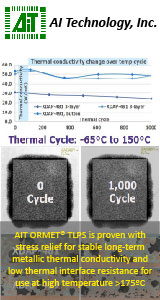|

|
|
| Ask the Experts | |||||||
|
|||||||
|
July 30, 2009 - Updated July 27, 2009 - Originally Posted Passive component void limitI know about voids in BGA component solder joints. Is there quality criteria for solder voids in passive components including resistor, capacitor, etc.? H. M. |
|||||||
| Expert Panel Responses | |||||||
|
It is commonly recognized that voiding is likely to occur when any two flat surfaces are soldered together. Voids are also common in plated-through hole connections. It is acknowledged that in many cases voids may actually be stress relievers and increase reliability of the connections. During reflow, the outer edges of the connection reach reflow temperature before the middle part. As a result, the melted solder effectively forms a seal around the termination and the volatiles present in the solder paste cannot escape. The result is voiding. It has always been present between two flat surfaces and always will be, but it can be reduced by process and stencil modification. Putting dots or stripes of paste on the land will somewhat reduce the anomaly. Baking more of the volatiles out of the solder paste before reflow will also reduce the amount of voiding. Make sure your solder paste has not been open too long and absorbed a lot of moisture before reflow. Another cause can be if the solder paste jar is too cool/cold when opened causing moisture to condense on/in the paste. Be sure to let the paste container sit long enough to completely reach room temperature throughout before opening. With the availability of low-cost x-ray systems, people are now looking at gull wing lead and chip terminal connections and becoming concerned about the voids they see. In many cases, these are being seen on mature products with ten or more years of field service, built using processes that they had previously qualified and haven't changed, and there is no failure history. The bottom line is that yes, there is voiding, but it may not be a failure mechanism, depending on the end-use environment. You will have to do environmental stress screening to qualify your process. IPC-9701 is a good document to support your connection qualification. Approach the analysis of voids cautiously. Let process qualification determine product acceptability. The IPC assembly and joining committees would welcome any data from tests that can be replicated to show that these kinds of voids are a failure mechanism. However, in nearly three decades of soldered SMT connections such data has yet to be presented.
Director - Certification & Assembly Technology IPC Mr. Crawford is Director of Certification and Assembly Technology for IPC. He is technical liaison to the IPC committees that maintain critical industry standards and has presented numerous papers internationally.
|
|||||||
| Submit A Comment | |||||||
|
Comments are reviewed prior to posting. You must include your full name to have your comments posted. We will not post your email address. |
|
Free Newsletter Subscription
Circuitnet is built for professionals who bear the responsibility of looking ahead, imagining the future, and preparing for it. Insert Your Email Address |
|

|



